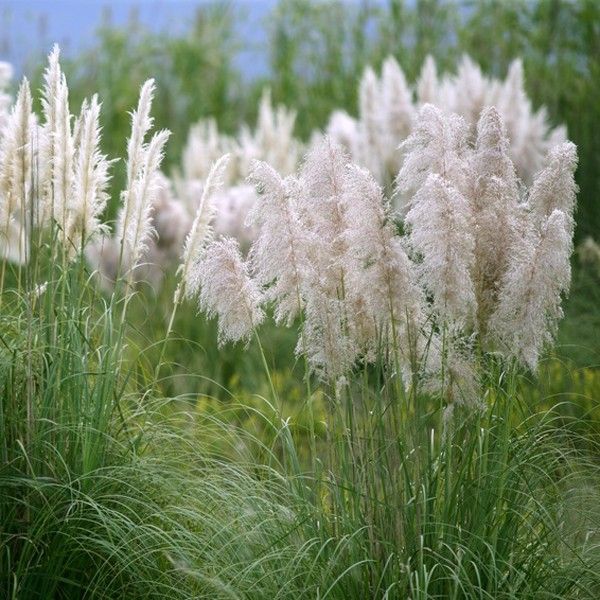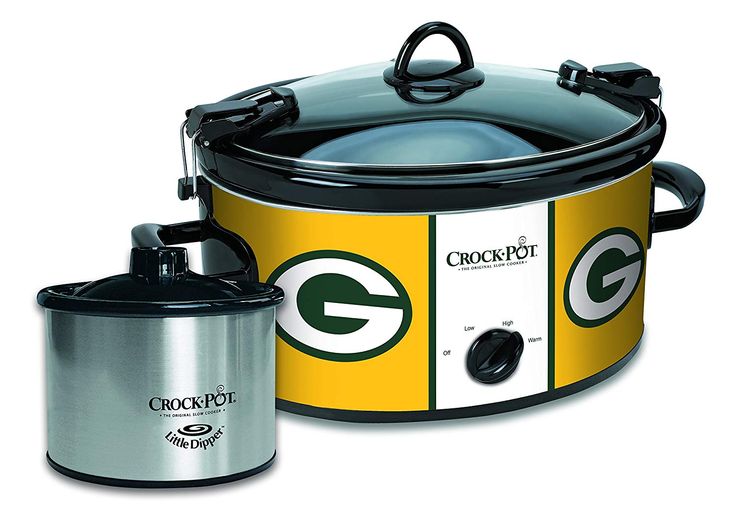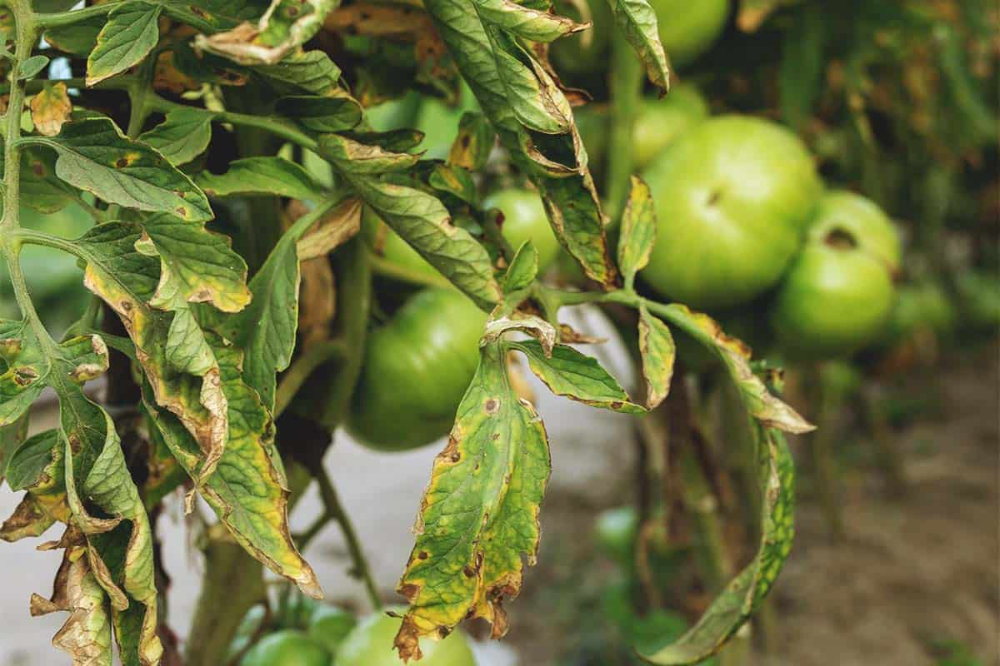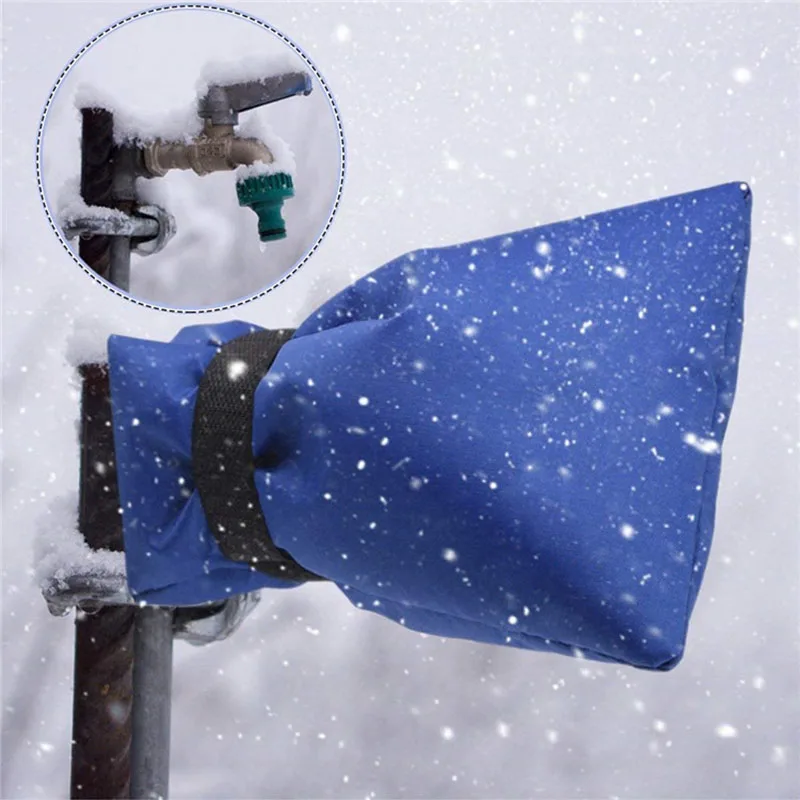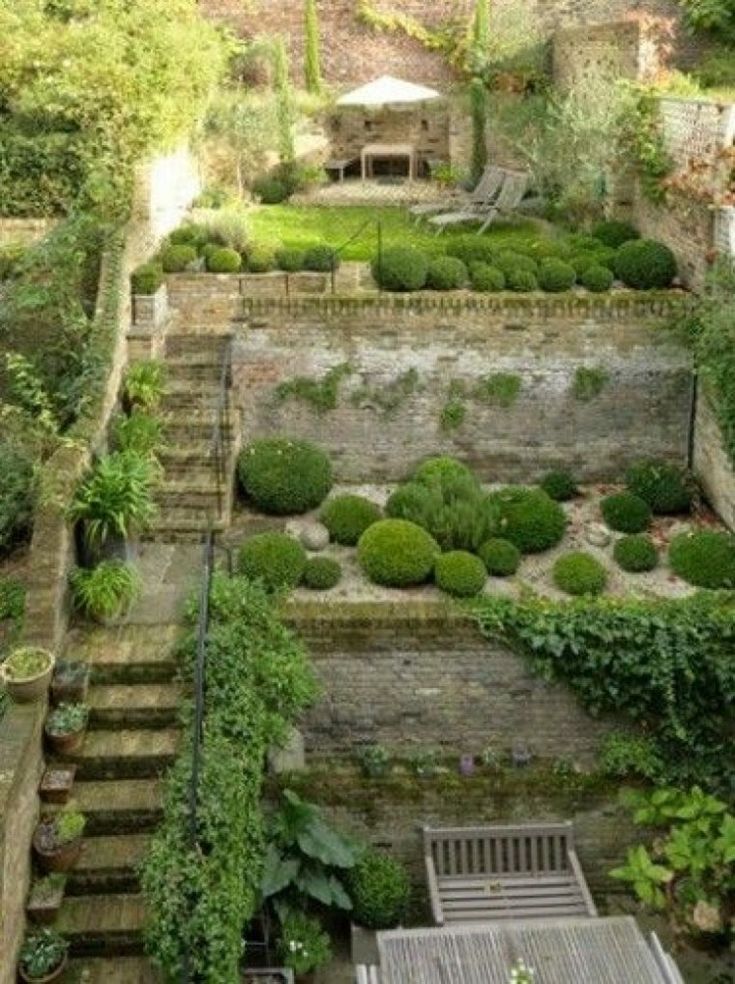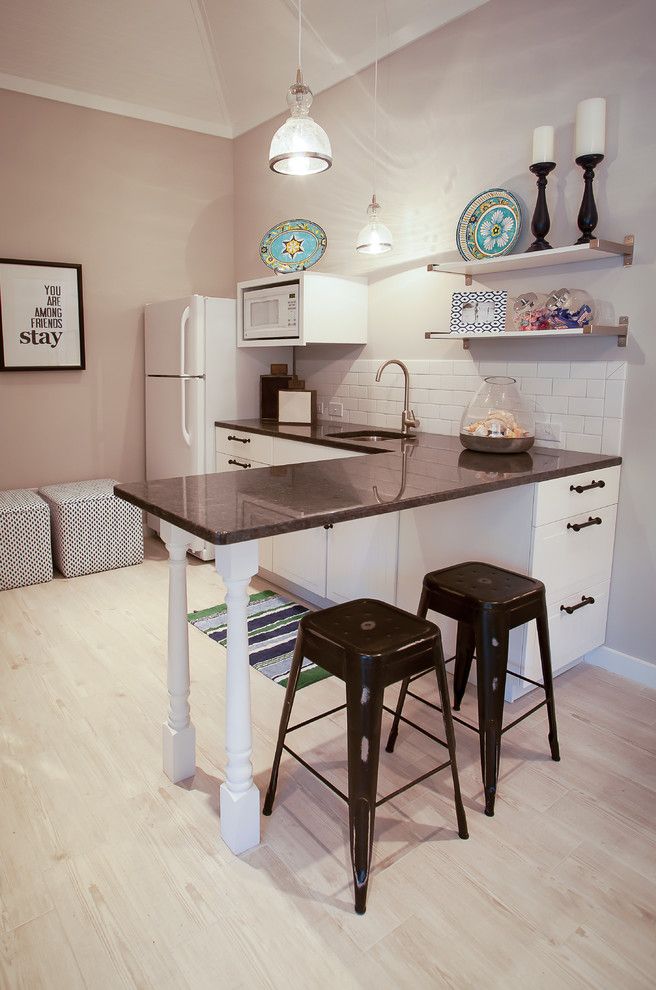Grow ornamental grass seed
How to Grow Ornamental Grass from Seed
If you’d like to learn how to grow ornamental grass from seed, I can tell you that I’ve learned a few tricks while experimenting last spring. Part of my seed growing challenge was growing several types of native prairie grasses which can also fall into the ornamental grass category.
There is probably no one, exact, right way to start ornamental grass from seed, but for practicality purposes, I’ve found that there are a few ways this process can be done with success. After trying several methods, method #2 worked best for us, but all 3 ways should work, provided you follow the seed packet’s suggestions. See, how to read and understand seed packets, here.
Method #1: Starting single seeds in seed growing pods, indoors, early to mid spring.
Planting 1 or 2 seeds into a seed pod is a slower method, but works in the long run.
Starting ornamental grass seed by planting 1 or 2 seeds per growing cell will work, just not as fast as method #2. And mind you, this was the suggested method on the seed packet. Not wanting to get creative and ruin the seed, this is how I stared my first batch of prairie grass seed.
This photo shows 5 mature single seedlings planted into a clump form.
The good news is, I was able to fix this problem, or perhaps I should say speed up the process. If you do decide to grow 1 or 2 seeds per growing cell, you can transplant them into a clump, when planting to ground. The photo above shows how I took 5 single, mature grass seedlings and planted them as a group, or clump.
This photo shows the same clump, one month later.
After one month, the grouping started to form a nice clump that will show very nicely the following year.
Method #2: Starting a clump of grass seed into a single growing pod, indoors, early to mid spring.
This is a photo of rye grass (aka Easter grass), but it’s a good example of what the pods will look like with a scatter of seeds rather than just 1 or 2.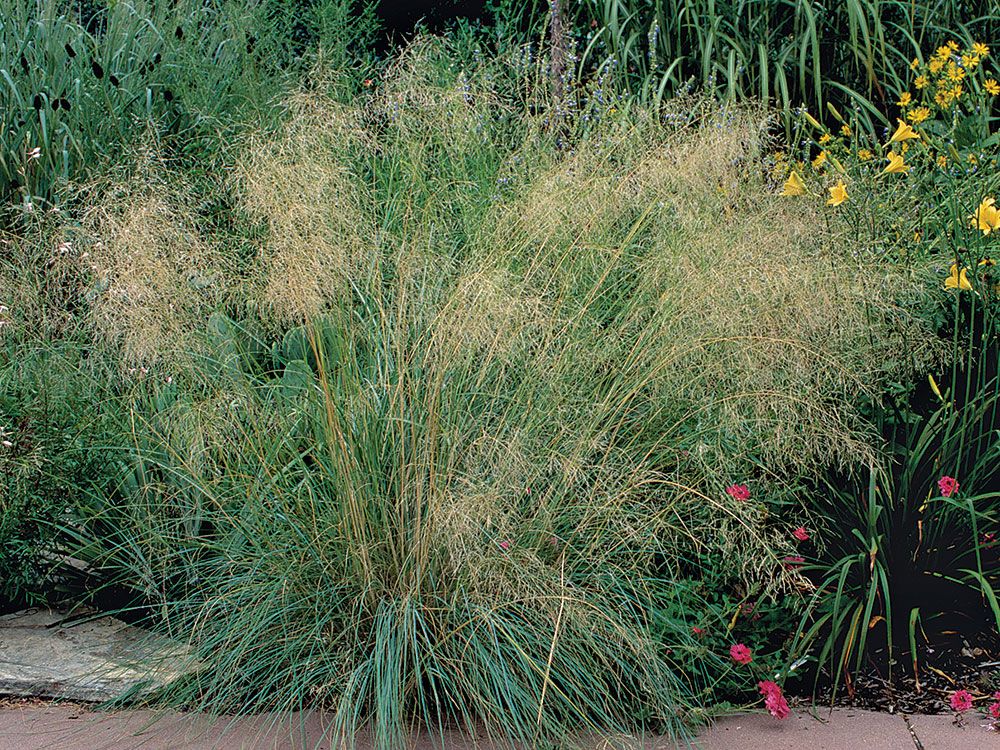
Last spring I grew some Easter grass. I scattered a bunch of the grass seed into each pod. The grass seed grew into beautiful clumps of Easter grass. I had to wonder if I could grow my prairie grass the same way.
I gave it a try and sure enough, growing the grass seed clump style in the seed starting pots worked really well. Note: some of the seed types don’t germinate as fast, and some prefer seeding directly to ground, but all in all, this method worked best.
It’s really that simple, and as long as you water and care for the grass per the recommended steps on the seed packet. You also want to make sure the perennial grass is a proper fit to your growing zone.
Method #3: Planting grass seed in clumps directly into the ground, outdoors in the fall.
While some types of grass will work well started indoors, many of the grass seeds can be planted clump style right into your garden in the fall for a spring or summer bloom the following year.
That brings us to the third way you can start ornamental grass from seed. And that is to plant seeds in groupings right into your soil. This would be as opposed to planting 1 or 2 seeds spaced out as you might do when planting certain vegetables. Now I can’t say that spacing out 1 or two seeds every few feet won’t eventually get you healthy clumps of ornamental grass, and boy that would save money, wouldn’t it. But the desired result of a nice, healthy clump of grass will take a lot longer to form, and all of the weeding you would have to do in the meantime could be frustrating.
And that is to plant seeds in groupings right into your soil. This would be as opposed to planting 1 or 2 seeds spaced out as you might do when planting certain vegetables. Now I can’t say that spacing out 1 or two seeds every few feet won’t eventually get you healthy clumps of ornamental grass, and boy that would save money, wouldn’t it. But the desired result of a nice, healthy clump of grass will take a lot longer to form, and all of the weeding you would have to do in the meantime could be frustrating.
If you decide to plant your ornamental grass seed right into the ground, one tip that I would suggest is marking off the area where the seeds have been planted. One good way to do this would be to cut the bottom 2/3rds off of a plastic planting pot and place the remaining circular piece into the soil around the grass seed. Including a plant marker will also help, if you are planting several different types of grass seed. The main idea, here is to be able to follow the progress of the seedlings while not confusing them with other plants or weeds that will most like start growing around the seedlings.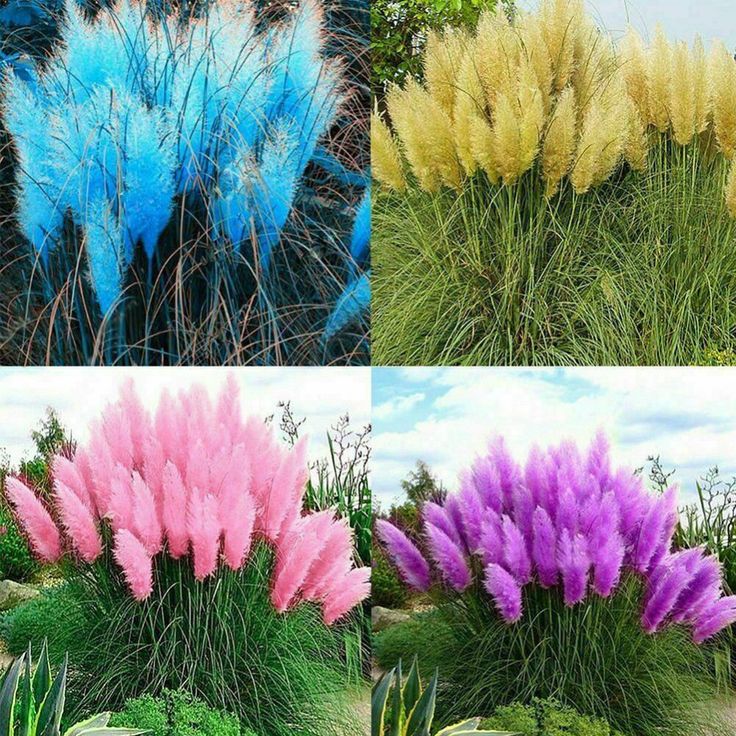
One last point to mention, if you’d like to plant the grass seed directly into the ground, is to make sure the area you are planting in is not going to get flooded during the first few months of seeding. We get heavy rain storms in the spring and fall where I live. That is why starting the grass seed in pods and transplanting to the ground turned out to be the best method for us, at least for that area of your yard. Some types of grasses, especially prairie varieties, actually grow best when planted in the fall, directly to ground.
Disclosure: The items below are affiliate links. If you purchase any of these products through the links, I receive a small commission, that way I can continue to provide you with helpful content. There is no extra charge to you for purchasing through my affiliate links.
Supplies to grow ornamental grass from seed indoors
Seed starting soil
Seed growing trays
– or – peat pots and planting trays
Plastic wrap (aka Saran Wrap)
Spray water bottle
Detailed steps to grow ornamental grass from seed indoors
Pour some of the seed growing soil into a bowl or container.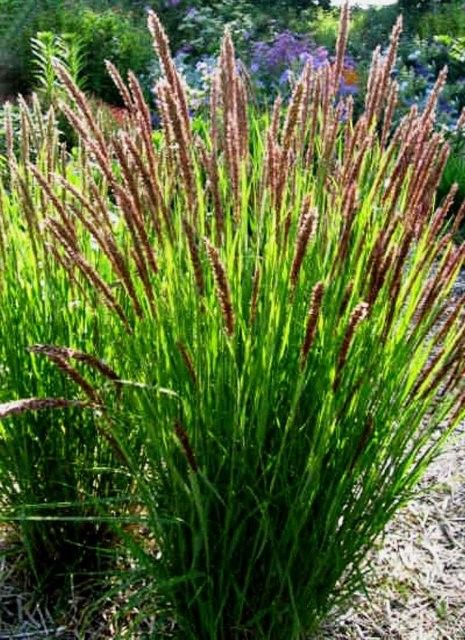
Dampen the soil by holding the container under the faucet. Stir the soil well the even out the dampness. Don’t soak it too much, just enough to dampen.
Fill the planting cells with the seed growing soil to just below the top. I used a spoon to scoop the soil into the pods.
Sprinkle the seeds onto the top of the soil. Tamp down.
Spritz the top using the spray water bottle.
Cover with plastic wrap.
Store in a warm area that gets part sun part shade.
Once a day, pull back the plastic and spray the soil with the water bottle.
Depending on the type of seed, seedlings will begin to sprout within 2 to 3 weeks, in most cases.
After seedlings have sprouted and strengthened for about 2 weeks, move them to the outside for the hardening off period, once there are no signs of frost outdoors.
Three main points to remember if you want to grow ornamental grass from seed are:
Ornamental grass typically shows best when grown in clump form.
When trying to choose which ornamental grasses to grow, keep in mind that the grasses that are more native to your area and proven to grow in your climate will do the best.
Not all ornamental grasses are the same. Make sure to read seed packets for the best method suggested to start that type of ornamental grass from seed.
Ornamental grass, whether native or not, can add depth to your landscape. Growing ornamental grass from seed is one way to save money, experiment and enjoy creating your own unique landscape or garden.
More Yard and Gardening Ideas:
Container Gardening with Herbs as Accents Plants
Tips for Starting a DIY Flower Bed
Fix for a Leaning Fence Post on a Budget – The Easy Way!
Like this idea? Pin or share on Facebook to reference later —>
Ornamental Grass Propagation - Learn About The Propagation Of Ornamental Grasses
The sway and rustle of ornamental grasses produce not only graceful beauty but a symphony of soothing sound.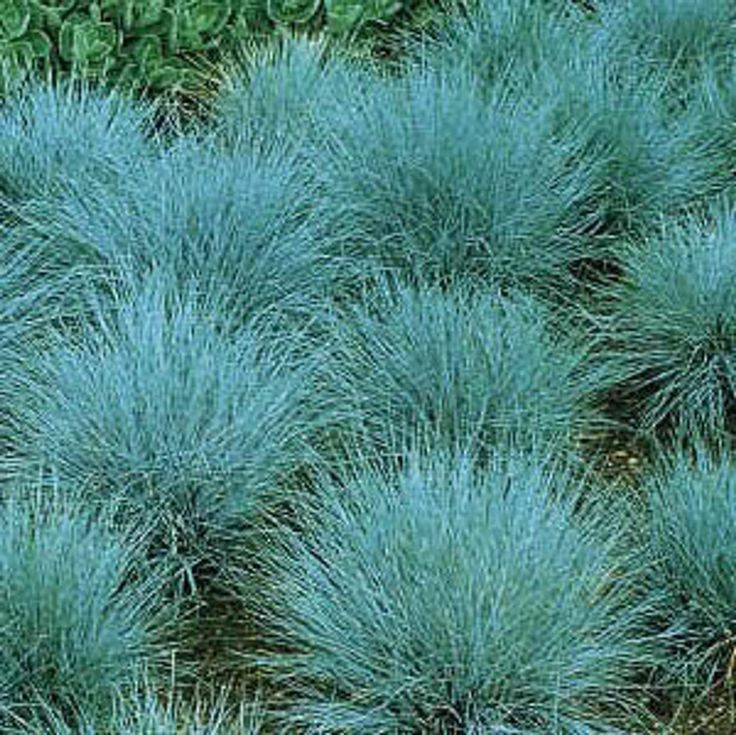 In most cases, dividing ornamental grasses is recommended every few years once they are established. This gives you the “2 for the price of 1” effect that budget minded gardeners appreciate, as well as increases and enhances the growth of the plants.
In most cases, dividing ornamental grasses is recommended every few years once they are established. This gives you the “2 for the price of 1” effect that budget minded gardeners appreciate, as well as increases and enhances the growth of the plants.
Ornamental grass propagation is easiest with this method, but some produce well with seed. Some notes on how to propagate ornamental grass will get you on your way to more free plants and a tumult of waving blades and gentle landscape movement.
Ornamental Grass Propagation
I have a little area I call my “Pointy Garden.” This is where all my ornamental grasses reside and provide an effective border and xeriscape ease.
Every few years, the plants need to be dug up and divided. It is often obvious when this needs to be done, as the grass may have a dead patch in the center or simply fail to produce a thick crown of leaves.
Propagation of ornamental grasses is through this division or from volunteer plants that have come from the prolific seed of many popular varieties.
How to Propagate Ornamental Grasses with Seed
Many grasses produce flowering stems that are also attractive and full of feathery seeds. Ornamental grass propagation through seed is fairly easy.
Collect seed when they are dry, usually in fall. Take the whole stem and allow the flower stalk to dry in a cool, dry place. You may choose to store them, but the best germination is with fresh seed.
Surface sow in good potting soil with just a dusting of sand on top. Water until the container is evenly moist and then place in a plastic bag or top with a plastic dome.
Germination differs by species, but once you have seedlings with two sets of true leaves, transplant them to larger pots to grow on. Harden them off in spring and install them in prepared containers or beds.
Dividing Ornamental Grasses
Seed is not the only method of propagating decorative grasses. A faster and more reliable method for the propagation of ornamental grasses is through division.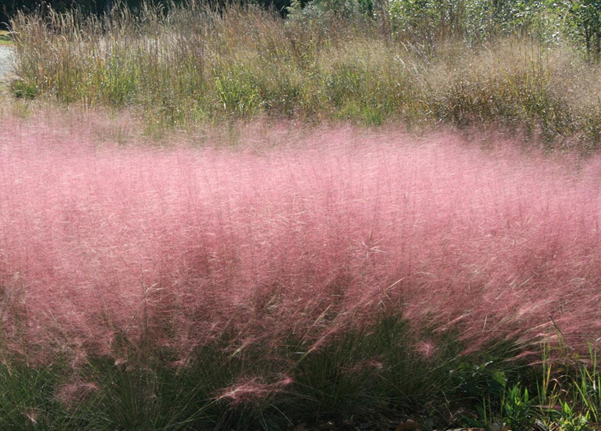 Many perennial plants benefit from division.
Many perennial plants benefit from division.
You simply dig up the plant when it is going dormant and cut it into two or more sections with healthy roots and leaves. Use very clean, sharp implements to make your cuts and discard any rotten or dead plant matter and roots.
Replant immediately and keep moist as the disturbed piece settles into its new home. By doing this, you can increase your stock of ornamental grasses every few years. Variegated forms need to be propagated by division in order to preserve the variegation. Variegated ornamental grass propagation will result in plain leaves, unlike the parent plant. Only cloning the plant material will retain the attribute.
Care After Propagating Decorative Grasses
Seeded species may be better off raised in containers for one to two years until they are large enough to fend for themselves. Actual care will depend upon the species, as some prefer dry conditions and others need consistent moisture.
Follow the same cultural care required by the parent plant.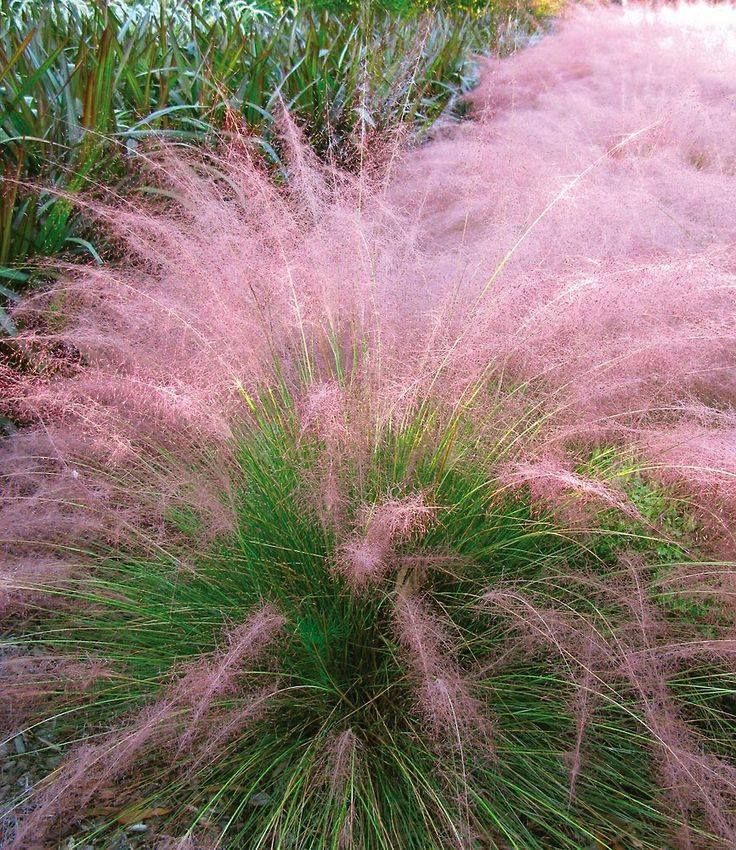 In all cases, keep competitive weeds from around the root zone and add a layer of organic mulch to protect roots and rhizomes in cold temperatures and conserve moisture.
In all cases, keep competitive weeds from around the root zone and add a layer of organic mulch to protect roots and rhizomes in cold temperatures and conserve moisture.
Divided plants may grow in containers or in-ground. Watch carefully for stress from sun, insects, and diseases, like fungal issues. Most propagation of ornamental grasses is straightforward and takes no special skill but has exponential rewards.
6 unpretentious cereals for container compositions. Sowing seeds. Care at home. Photo — Botanichka
The fashion for decorative cereals in landscape design could not help but migrate from gardens to balconies and loggias. In the US and Europe, annuals in containers are increasingly placed in company with ornamental grasses. A few years ago, I also decided to add cereals to my balcony arrangements and flower beds in my garden. What ornamental grasses are easy to grow from seedlings? Which of them are able to winter well in the middle lane, and who is destined for the fate of an annual? Will cereals bloom in the year of sowing, and with what flowers can they be successfully combined? In this article I will talk about six cereals that I successfully use in balcony compositions and flower gardens.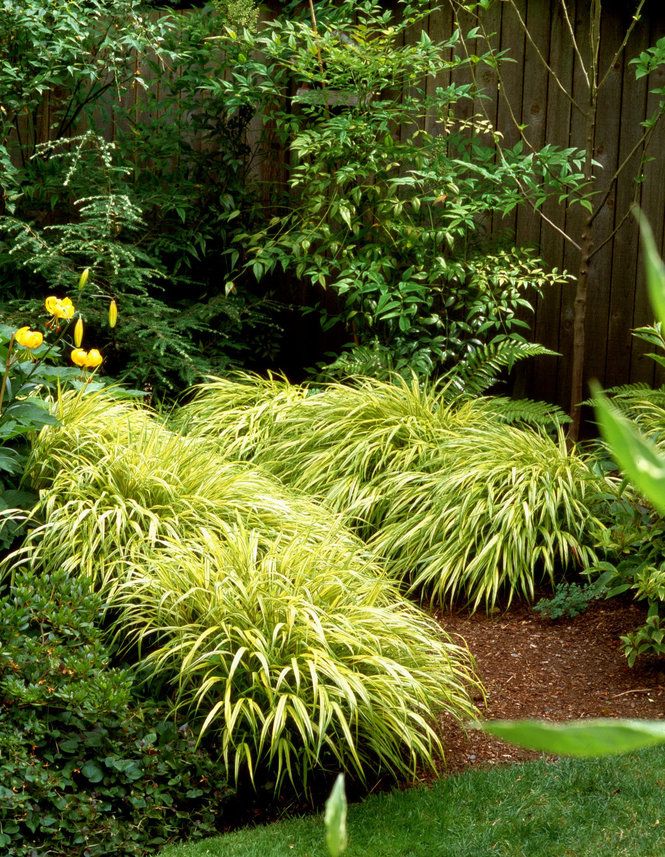
For me, growing cereals in compositions with summer flowers is not just a tribute to fashion or blind copying of garden magazines. In the company of discreet herbs, annual flowers begin to look completely different - more solid and stylish. Cereals give structure to compositions, add air, movement and sound to plantings at the slightest breath of breeze.
In addition, as it turned out, growing most cereals from seeds is no more difficult than preparing seedlings of petunias or other unpretentious annuals.
1. Finest feather grass
The most common variety of this type of feather grass "Pony Tails" ( Pony Tails ). The name of the cultivar in translation from English means "horse tail", which, perhaps, indicates the resemblance of a shock of the thinnest spikelets of a plant with a horse's hair.
The thinnest feather grass (Stipa tenuissima). © Lyudmila Svetlitskaya Feather grass grown from seeds usually blooms only in the 2nd or 3rd year, so I never managed to see the flowering of this grass with my own eyes because of its low frost resistance.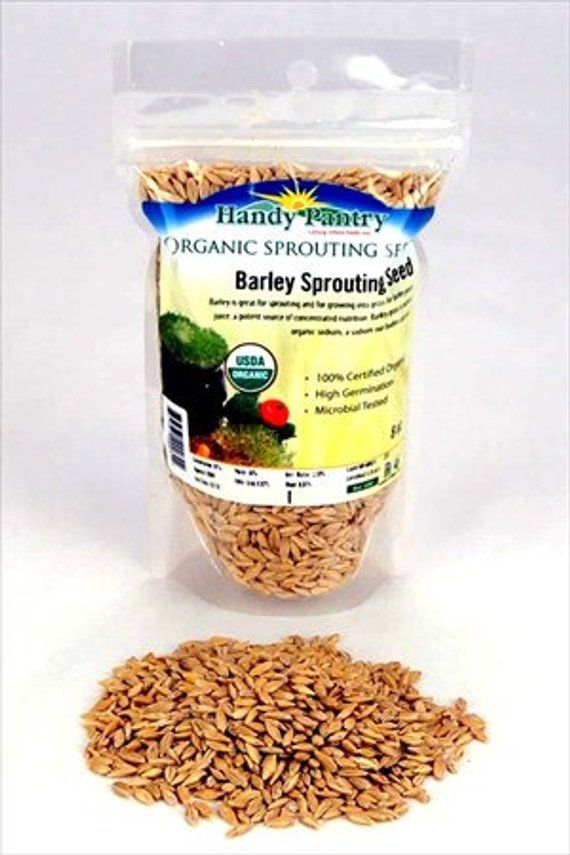 However, the dense clumps of narrow linear leaves are no less reminiscent of a ponytail and look very attractive.
However, the dense clumps of narrow linear leaves are no less reminiscent of a ponytail and look very attractive.
The thinnest feather grass reaches the stated height of 40 centimeters only in flowering state, therefore, in an annual crop, it is a low-growing compact grass suitable for small containers.
Pony Tails seeds germinate very easily within a week without cold stratification or other additional procedures. The growth rate of seedlings is average. Therefore, in order to get fluffy curtains by the beginning of May, it is better to sow the seeds indoors in February-March.
On my balcony, I liked to combine this cereal with petunia the most. Both plants are very photophilous and responsive to feeding. In addition, such a duet looked original and allowed us to perceive the usual annual plant in a completely different way.
Unfortunately, this type of feather grass belongs to the 6th frost resistance zone, therefore it is not able to endure frosts below -20 degrees.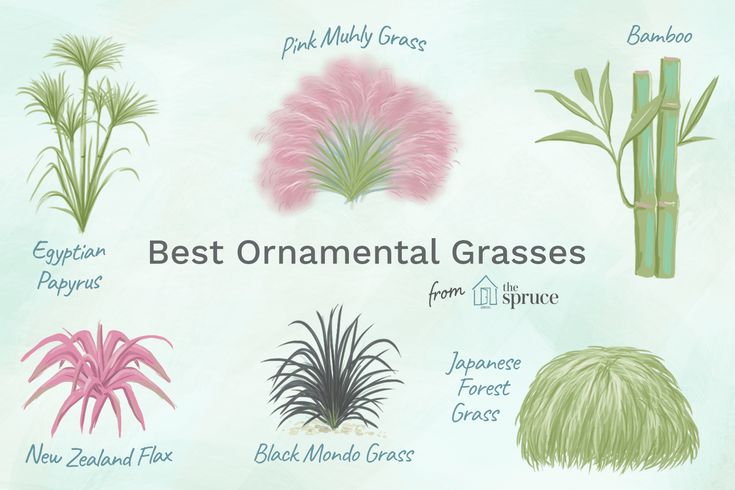 Attempts to keep containers with feather grass in a cool basement at +10 degrees were unsuccessful. Wintering in the ground with good shelter also ended in failure. However, I grow this herb every year in an annual crop to add airy greenery to the showy annual flowers.
Attempts to keep containers with feather grass in a cool basement at +10 degrees were unsuccessful. Wintering in the ground with good shelter also ended in failure. However, I grow this herb every year in an annual crop to add airy greenery to the showy annual flowers.
The unusual Fireworks feather grass (originally a Sirocco hybrid) is also often found on sale, whose foliage changes color from green to shades of copper and pink with decreasing temperature. Often, seed producers are a little tricky, designating a hybrid as a perennial, without indicating its degree of winter hardiness. However, this cultivar also belongs to zone 6, which means that feather grass cannot withstand temperatures below -20 ... -23 degrees, and in the middle lane it is grown only as an annual crop.
2. Hairy sedge (Carex comans)
Hybrid Amazon Mist slightly drooping crescent-curved leaves.
Hairy sedge (Carex comans). © Lyudmila Svetlitskaya The textured narrow foliage of the hairy sedge is light green in color, it turns out to be quite hard to the touch, because of which from a distance (unknowingly) the plants can be mistaken for artificial grass.
Sedge Amazon Mist is especially spectacular in windy weather, due to the fact that the reverse side of the foliage is distinguished by a silvery color. It creates a characteristic shimmering effect in the wind.
The name of this grass is well known to everyone who spent summers in the country as a child, and it seems that the hybrid variety should be as resistant as the famous weed. But, alas, the hairy sedge is a heat-loving variety of the usual grass native to New Zealand and does not tolerate temperatures below -23 degrees.
Sedge blooms at the end of summer with inconspicuous spikelets, however, flowering, in any case, occurs only in the second year when grown in the southern regions. At a young age, sedge grown from seeds grows rather slowly, so it is best to sow in the middle to late winter.
Germination takes about a week, at which time it is best to keep the containers on a well-lit windowsill or under a fluorescent lamp. Once planted in its permanent location, this original ornamental grass needs minimal maintenance if placed in a sunny spot and watered regularly.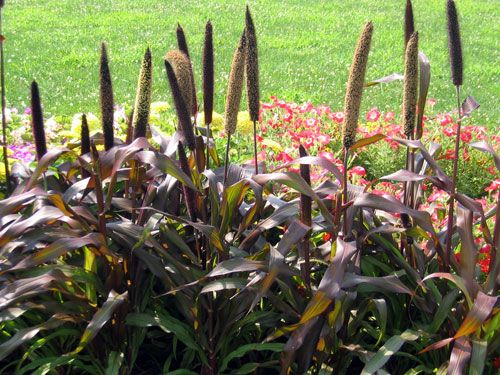 In some cases, individual brown leaves have to be removed from curtains, but this problem is extremely rare.
In some cases, individual brown leaves have to be removed from curtains, but this problem is extremely rare.
Sedge Amazon Mist grows in a low neat tussock, so it is better to choose low compact annuals with medium-sized flowers as partners. I liked pairing it with hybrid nemesia, bacopa, mimulus, viola, caliberchoa, dwarf snapdragon, etc.
The hairy sedge has other equally interesting varieties. For example, the hybrid Red Rooster is attractive with red-bronze foliage. A culture Bronco features textured bronze brown curtains. Both hybrids are also not very winter hardy and are grown in the middle lane as annuals.
3. Pennisetum, or "fountain grass"
Pennisetum surprises with fluffy brush-shaped inflorescences, the structural shape of the bush and elegant foliage. On sale you can find the seeds of several species of this cereal, but for cultivation in the middle lane, foxtail pennisetum is best suited ( Pennisetum alopecuroide ) and oriental pennisetum ( Pennisetum orientale ).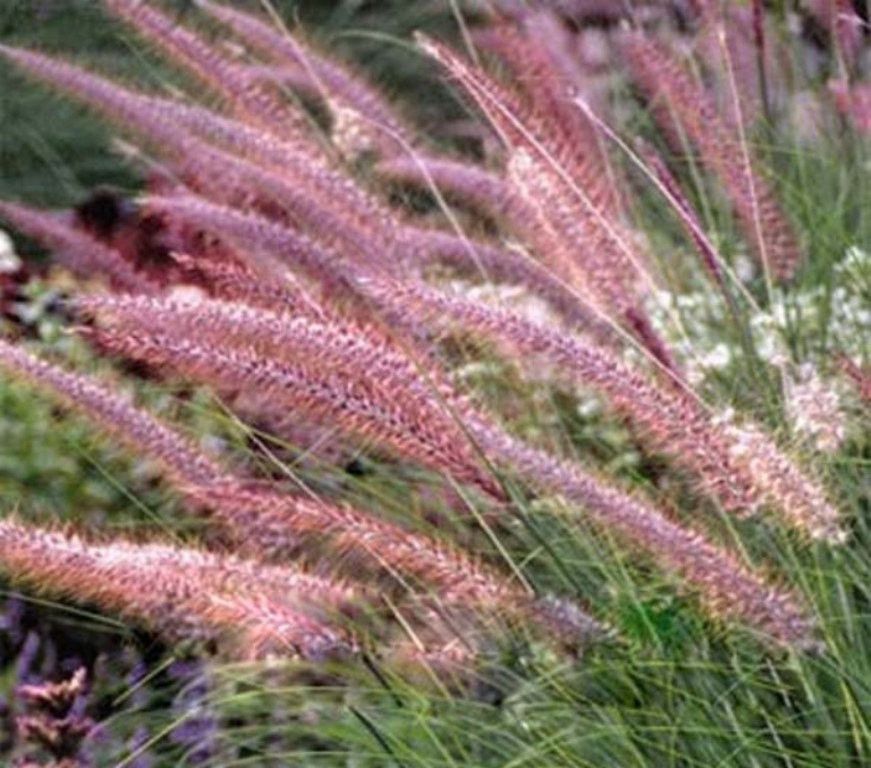
These varieties have a fairly high winter hardiness (withstand negative temperatures of about -29 degrees), so they can be cultivated in a perennial crop and winter well in flower beds under light cover.
Growing pennisetum from seeds is not difficult. If you plan to use it as a perennial garden plant, then the seeds can be sown in May directly into the ground. But to decorate balconies, I prefer to grow pennisetum early - through seedlings.
Grass seeds are rather large, but it is still better not to sprinkle them with earth, but to gently press them into the substrate with a toothpick. Seedlings are usually not long in coming and appear after 7-10 days.
If you sow pennisetum at the end of winter, you can see flowering already in the year of sowing. Of course, in the first year it will not be so plentiful and will begin only in mid-September. But, nevertheless, the original bristly "brushes" will be a wonderful decoration for autumn container compositions.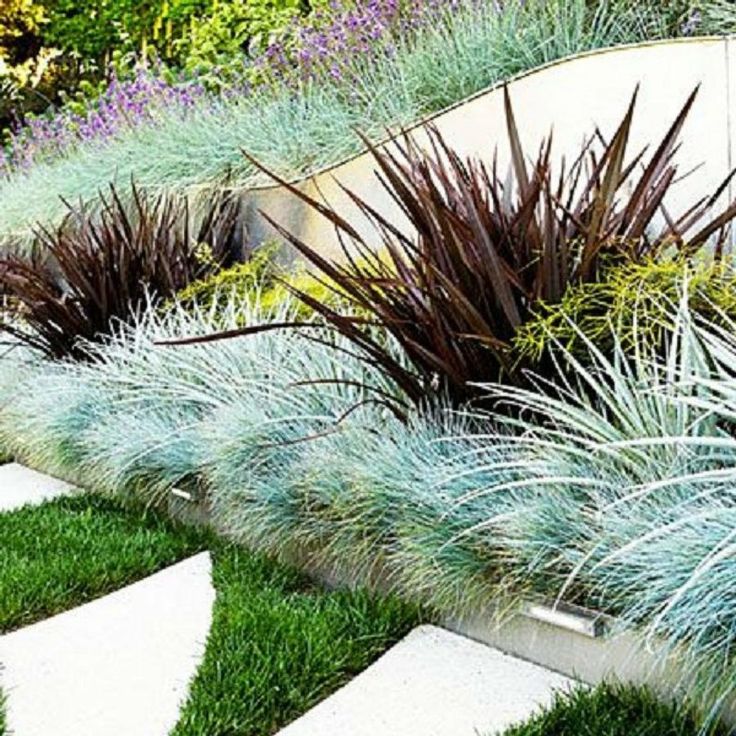
Pennisetum is quite a tall grass, so it can be used as a central accent of a tub composition. At the foot of ornamental grass marigolds, dwarf zinnias, undersized dahlias, petunias and other bushy annuals with large expressive flowers will look harmonious.
In autumn it is better to transplant the bushes into open ground. In order for the wintering of pennisetum in the garden to be successful, it is recommended to tie the stems into bunches, spud with peat and cover with spruce branches.
Colorful pennisetum bluegrass , also known as ornamental or African millet, with purple leaves and monumental burgundy cobs, is also easy to grow from seed. However, you should know that this is one of the most thermophilic types of pennisetum, and the plant will please the grower for only one season.
4. Breeze, or shaker
Medium breeze ( briza media ) is a common meadow plant of temperate climate. This pretty grass is widely known among the people under the name "cuckoo's tears".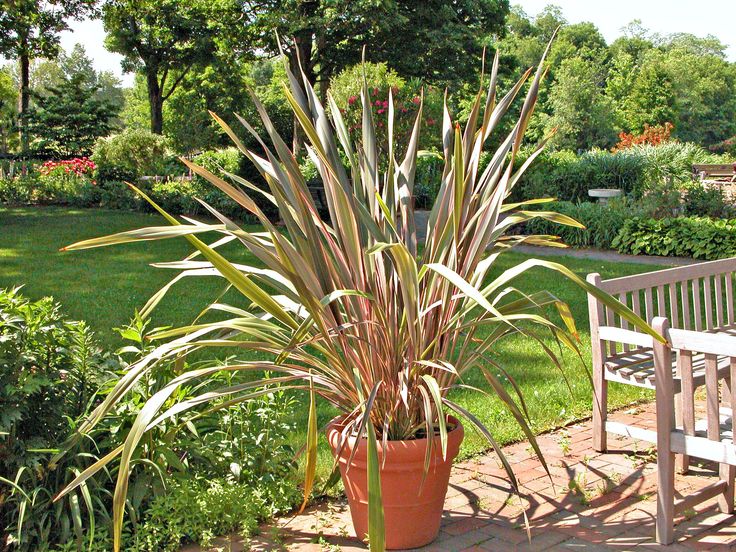 But among flower growers, the most widespread was big shaker ( briza maxima ), which is most often used to make original winter bouquets.
But among flower growers, the most widespread was big shaker ( briza maxima ), which is most often used to make original winter bouquets.
The breeze buds resemble small, flattened, teardrop-shaped catkins that sway and shake easily in the slightest breeze (hence the name, "shaker"). The clumps of this grass look rather loose, and the simple linear leaves are of little decorative value, so I prefer to plant the breeze so that bushy plants camouflage its foliage.
Since breeze bushes grow poorly in width, for the greatest decorative effect, they must be planted in a group, placing seedlings as close as possible to each other.
"Cuckoo's tears" can find their place in compositions with petunias, snapdragons, heliotrope, vervain and other bright annuals from 20 to 40 centimeters high.
Large Briza is an annual by nature. However, this small drawback is compensated by incredibly fast growth and early flowering.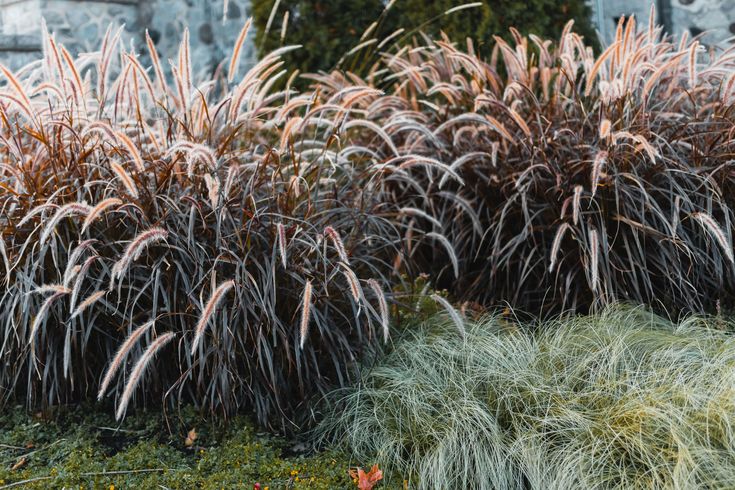 An annual shaker can be sown in a permanent place in early May. Shoots appear quickly, and seedlings do not require special care. Flowering begins in July-August.
An annual shaker can be sown in a permanent place in early May. Shoots appear quickly, and seedlings do not require special care. Flowering begins in July-August.
I would also like to note an equally interesting variety of long-term medium breeze Russels . The original cereal, in addition to pretty inflorescences, is notable for striped silver-white foliage. The plant is characterized by unpretentiousness and cold resistance, it develops better in the sun, although it also tolerates light partial shade. In height, this shaker reaches 60 centimeters along with peduncles, and it is better to plant it in garden flower beds, where the breeze can winter without any shelter. Since the Russels shaker is of hybrid origin, it is better to propagate the grass by dividing the bush.
5. Snow white oyster
Rare original grass is not currently widely used in gardens or on balconies, and this is not due to the external features of the plant or the difficulty in growing the crop. The fact is that many gardeners simply do not know about the existence of such an ornamental plant, otherwise they would certainly want to put an ozhika in a flower garden, as it once happened to me. After all, this amazing cereal has a lot of advantages.
The fact is that many gardeners simply do not know about the existence of such an ornamental plant, otherwise they would certainly want to put an ozhika in a flower garden, as it once happened to me. After all, this amazing cereal has a lot of advantages.
First, the plants form evergreen tussocks that retain their foliage all year round. Secondly, grass with a rather exotic appearance is absolutely winter-hardy in the middle lane. And thirdly, ozhika is one of the few cereals that will feel great in partial shade.
The original feature of the snow-white oyster is the presence of a fluffy coating on the edge of the leaf blade, similar to hoarfrost or a light snow cover. At the beginning of summer, neat bushes adorn abundant openwork paniculate inflorescences, consisting of small grayish-white flowers, also resembling fluffy snow flakes.
Since the sedge is a close relative of the sedge, it is also quite moisture-loving and feels good in partial shade with sufficient moisture, for example, on the shore of a reservoir.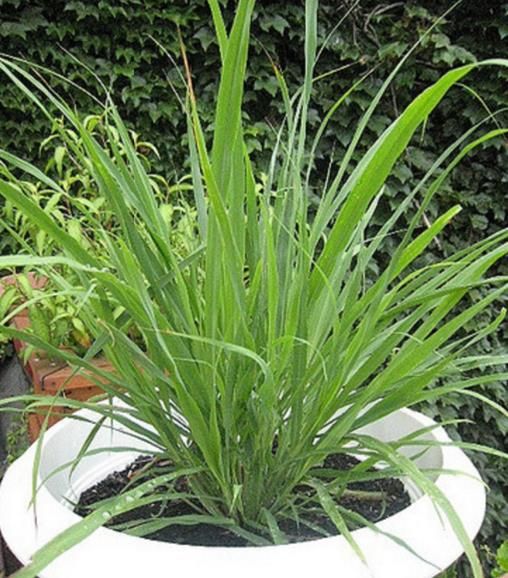 However, plants grow well with moderate watering in sufficient sun, in combination with a variety of perennials or annuals in flower beds and in flower beds.
However, plants grow well with moderate watering in sufficient sun, in combination with a variety of perennials or annuals in flower beds and in flower beds.
Ozhiki, as a rule, have a decent height and bush diameter (45-60 cm). And for balcony boxes or small gardens, a hybrid dwarf variety 9 is suitable.0011 Luzula Lucius 15 to 30 cm tall. In container compositions, the original cereal will make harmonious combinations with balsam, ever-flowering begonia, mimulus and other undersized annuals for light or semi-shady places.
The hybrid can be propagated not only by dividing the bush, but also easily grown from seeds. You can also sow the ozhiku before winter, or grow seedlings indoors, sowing in March. Small seeds are usually sold in granules, which are conveniently lightly pressed into the substrate with a damp toothpick.
There are no special problems in growing seedlings. Subsequently, in the flower beds, the oyster gives abundant dense self-seeding, which can interfere with the growth of mother plants, so it is recommended to remove excess seedlings.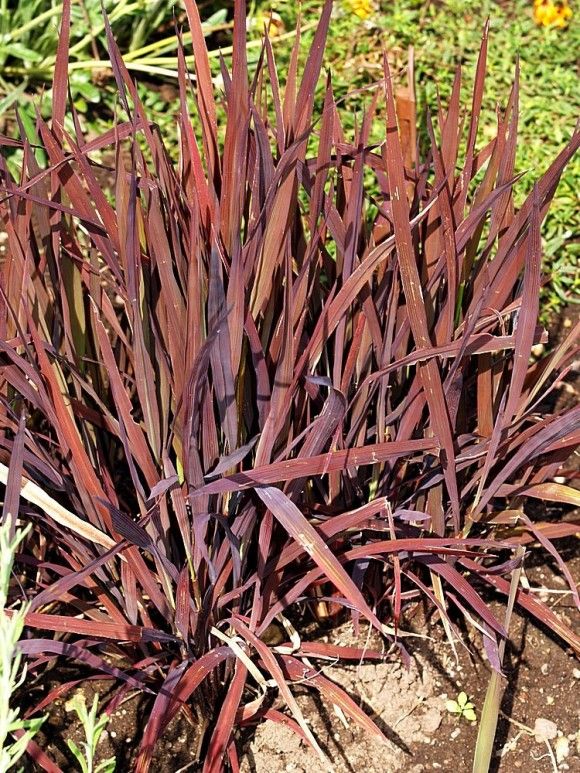 In snowless winters, the evergreen foliage of the grass can be damaged, but in the spring it quickly recovers.
In snowless winters, the evergreen foliage of the grass can be damaged, but in the spring it quickly recovers.
6. Haretail, or Lagurus
Charming "hare tails" are difficult to confuse with any other representative of cereals. The main advantage of the plant is precisely the unusual dense egg-shaped inflorescences 3-4 centimeters long, blooming on long thin stems. At the beginning of flowering, spikelets are pinkish-gray, and later change color to pure white. Florists often use such original inflorescences for winter bouquets.
Haretail, or Lagurus (Lagurus ovatus). © forumhouse Most often, lagurus is grown exclusively as a dried flower, but the fashion for natural flower beds made it possible to see a full-fledged participant in mixborders and container compositions in the haretail. The height of the plants is 30-50 centimeters, while the bushes practically do not grow in width, therefore, to achieve the greatest effect in flower beds, the haretail is planted in large arrays, placing the plants in a group at a distance of 10-15 centimeters from each other.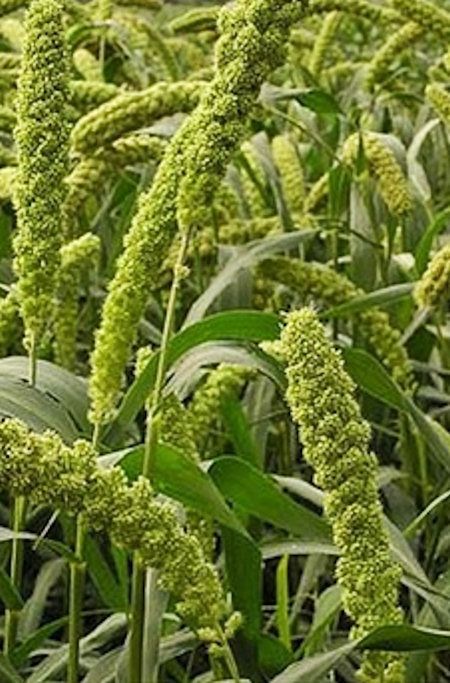
By nature, lagurus is a fast-growing annual, so the seeds can be sown directly into the ground in early May. But I prefer to sow them for seedlings indoors in late March/early April so that the charming "hare tails" appear as early as July.
Germination of seeds takes 10-12 days, seedlings do not require special care. The haretail prefers sunny places, poor soils, and moderate watering, and, if necessary, tolerates drought well.
In container gardens, the haretail will become a vertical accent of the composition. If you place it in the center of the container, surrounded by bright annual flowers (petunia, ever-flowering begonia, undersized snapdragons, marigolds, etc.), branched bushes will hide the unattractive lagurus foliage, and bright inflorescences form an expressive contrast with fluffy light spikelets.
Ornamental grasses | What to plant?
Home »
Ornamental grasses with photos and names
Ornamental grasses in landscape design photo
Ornamental grasses are a group of plants with about 200 varieties.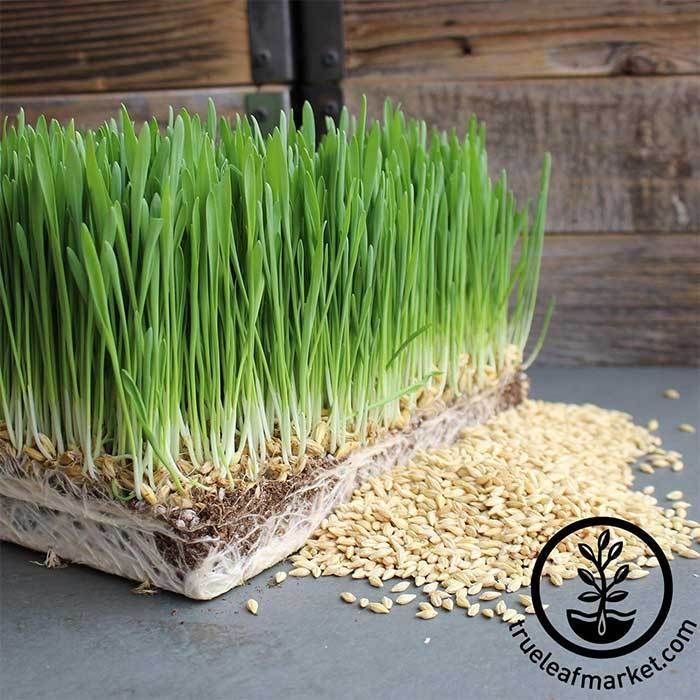 They are getting more and more popular. They are an excellent background for brighter plants, used to decorate ponds, alpine slides, rockeries, framing flower beds, garden paths, fit literally into any design. With the onset of autumn, their fluffy panicles will dilute the sad time. They can also be harvested, painted, used for the subsequent creation of dry bouquets.
They are getting more and more popular. They are an excellent background for brighter plants, used to decorate ponds, alpine slides, rockeries, framing flower beds, garden paths, fit literally into any design. With the onset of autumn, their fluffy panicles will dilute the sad time. They can also be harvested, painted, used for the subsequent creation of dry bouquets.
May be annuals or perennials. They are divided into tall (up to 90 cm tall) - cortaderia, miscanthus; medium tall (40-90 cm) - feather grass, maned barley; undersized (15-40 cm) - haretail, lamarckia, fescue.
How to take care of ornamental grasses
Ornamental grasses for the garden landscaping use
- Ornamental grasses can grow in poor soils, so fertilization is not worth it. The site must not be flooded.
- The soil must be dug up, weeds must be removed, the surface of the soil must be leveled. Sow the seeds taking into account the growth of an adult bush.
- Such plants are mainly content with moisture from rainfall, watering is required only in very dry weather.
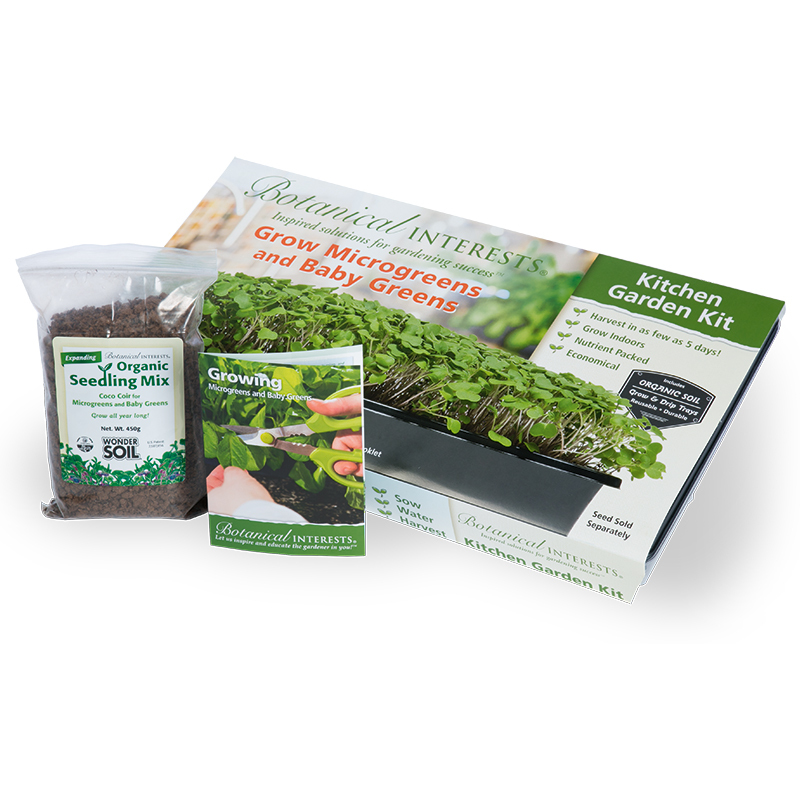
- Moisture-loving are sedge, miscanthus, reed, falaris, calamus grass - water them occasionally.
- Poorly tolerate moisture fescue, cylindrical emperor, oat grate, reed grass.
The brightest representatives of ornamental grasses
In addition to plants with fairly uniform paniculate fluffy inflorescences, there are even more interesting ones:
- Imperata cylindrica - the tips of the leaves have a burgundy hue, and in autumn the leaves turn completely purple.
- Chasmanthium latifolium - flattened inflorescences, beautifully hanging catkin plates.
- Ornamental sorghum - a loose ear consists of large grains of dark brown color.
- Pennisetum bluegrass (ornamental millet) - brown-violet leaves, dense panicles, color varies from red to almost black.
Ornamental grasses play an important role in landscaping, being a spectacular touch in multi-tiered compositions. The apparent simplicity of these plants beautifully emphasizes the dignity of more expressive neighbors in the flower bed.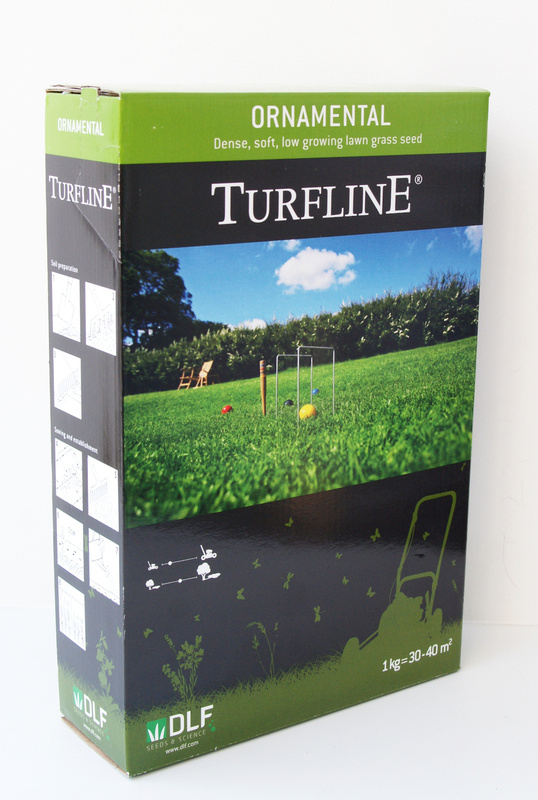 Read more about the use of cereals in landscape design in separate articles about the species in question.
Read more about the use of cereals in landscape design in separate articles about the species in question.
Ornamental grasses for the garden 2018/06/16
Muhlenbergia hairy Growing from seeds Planting and care in the open field Photo of varieties
Muhlenbergia hairy (Muhlenbergia capillaris) is an ornamental grass that is actively grown in the West, rarely found in our gardens. The bushes look unusual and very beautiful: a pinkish or purple haze can be seen from afar, creating an atmosphere of mystery and mystery. Muhlenbergia…
Ornamental grasses for garden0197
Millet (lat. Panicum) is an annual or perennial plant of the Cereal (Poa) family. The height of herbaceous stems varies from 30 cm to 2 m. The bushes are sprawling. Leaf blades are flat, linear-lanceolate. The length of the paniculate inflorescence is 15-40 cm. From the back…
Ornamental grasses for the garden herbaceous perennial of the grass family. Grows in the form of a bush.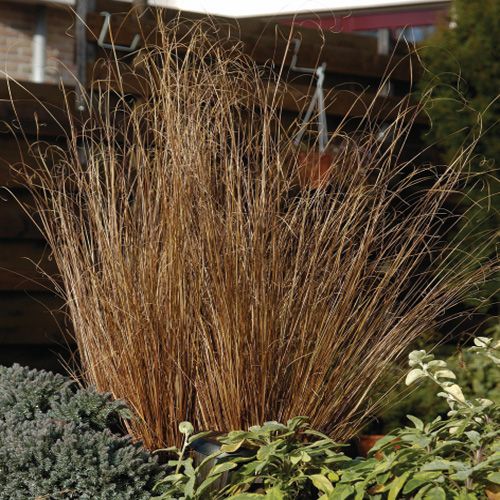 The leaves are narrow, long (about 40 cm), spread out like a fountain. Flowering stems are erect, reach a height of 1.5 m. They end in fluffy paniculate inflorescences. AT
The leaves are narrow, long (about 40 cm), spread out like a fountain. Flowering stems are erect, reach a height of 1.5 m. They end in fluffy paniculate inflorescences. AT
Ornamental grasses for the garden 2018/04/06
Lawn grass perennial pasture ryegrass Description Growing from seeds and care Photo
Creating an ornamental corner with a luxuriously manicured lawn is a task that requires effort, a lot of patience and time. Not every owner of the site can cope with such a task. It is necessary to choose the right kind of lawn grass, then there is everything ...
Ornamental grasses for the garden0197
Soddy pike, soddy meadow grass or deschampsia (Deschampsia cespitosa) are all names of the same plant. It is a herbaceous perennial of the Cereal (Poa) family. It grows in a bush-knob, forming a dense turf. Botanical description The height of the bush varies from 20 cm ...
Ornamental grasses for the garden 2018/04/05
Sesleria blue and shiny, black-flowered Planting and care in the open field Photos of species
Sesleria (Sesleria) is a perennial evergreen plant of the Cereal family.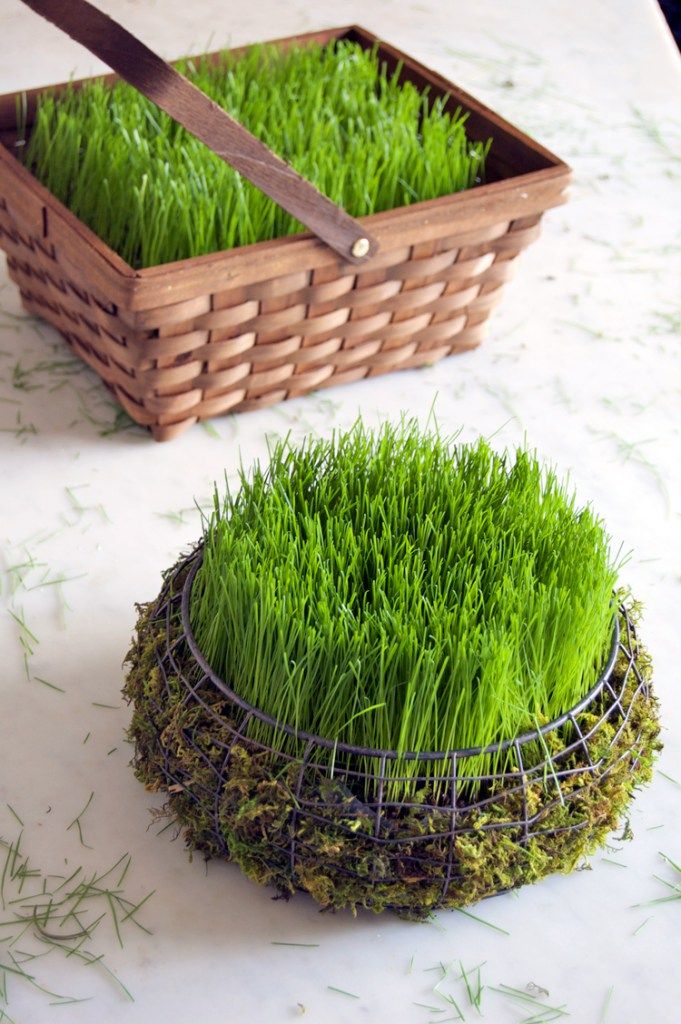 It is a tussock bush with a height of 20 cm to half a meter. Creeping rhizome. The basal rosette is formed by many long narrow-linear leaf plates. They are two-color: the upper and lower surface of the sheet have ...
It is a tussock bush with a height of 20 cm to half a meter. Creeping rhizome. The basal rosette is formed by many long narrow-linear leaf plates. They are two-color: the upper and lower surface of the sheet have ...
Ornamental grasses for the garden 2018/04/04
How to grow Chasmanthium broadleaf from seeds Planting and care in the open field Photo of wild oats It has a number of other names: wild or forest oats, broad-leaved flat grate, uniola. The natural habitat is the southwestern regions of North America (extends from Texas to ...
Ornamental grasses for the garden 2018/04/04
Sheep evergreen or viviparous, blue, paniculate Planting and care Photos of species and varieties
The simple appearance of ornamental grasses makes them versatile in landscape design. Most often they are used to decorate alpine slides, discounts, mixborders. They even create special gardens from cereals - a spectacle similar to the natural steppe. Sheep will definitely become…
Ornamental grasses for the garden 2018/04/03
Stipa growing from seeds Planting and care in the open field Types of feather grass with photos and names
Botanical description of the most beautiful feather grass The most beautiful feather grass is a perennial herbaceous plant of the Cereal (Poa) family.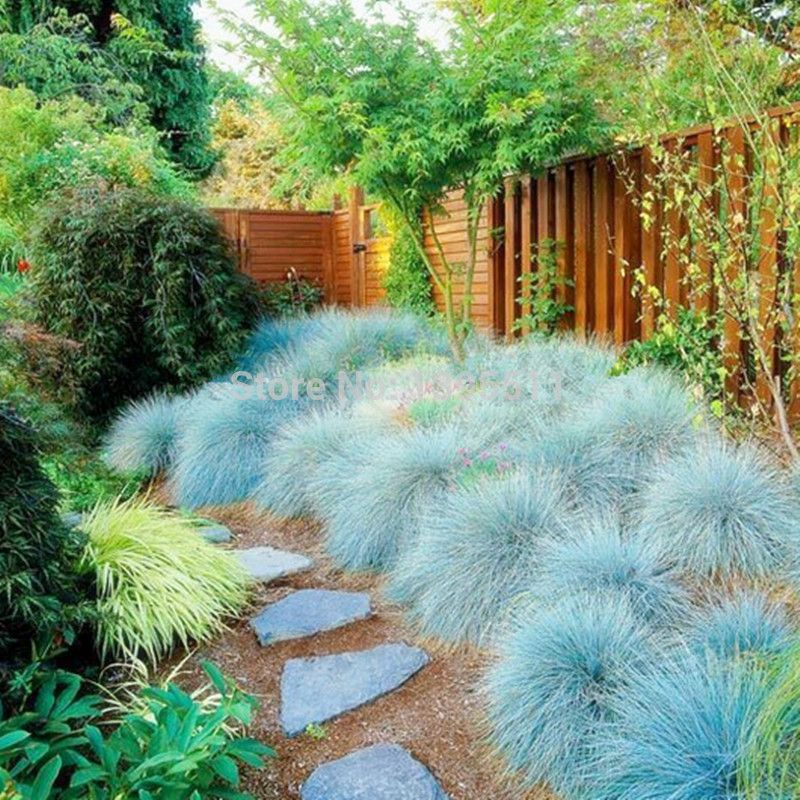 In the natural environment, it is found in the steppes and rocky areas of Central Asia, Europe, Western Siberia, and the Caucasus. Able to climb to the upper belt of mountains. Carries ...
In the natural environment, it is found in the steppes and rocky areas of Central Asia, Europe, Western Siberia, and the Caucasus. Able to climb to the upper belt of mountains. Carries ...
Ornamental grasses for the garden0197
Miscanthus (Miscanthus) or fan - belongs to the genus of perennial herbaceous plants of the Cereal (Poa) family. A close relative of sugar cane, but the sugar content of the stems is much lower. The natural habitat is the tropical and subtropical regions of Africa, Australia, ...
Ornamental grasses for the garden , ornamental millet is a perennial herbaceous plant of the Cereal family. The name is derived from two Latin words meaning "feather" and "bristle", which is why it is also called pinnate. The look justifies it. Spikelets of the plant are gathering ...
Ornamental grasses for the garden 2018/03/31
Cortaderia or pampas grass for summer cottage How to grow from seeds Planting and care Photo
Cortaderia selloana or pampas grass is a perennial herbaceous plant of the Cereal (Bluegrass) family.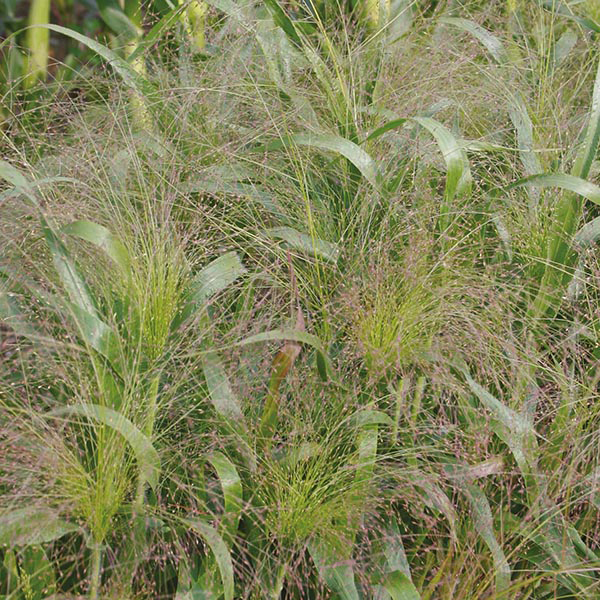 Grown exclusively for decorative purposes. When favorable conditions are created, it reaches a height of 2.5-3 m - the bush rises monumentally in the summer cottage. Leaves…
Grown exclusively for decorative purposes. When favorable conditions are created, it reaches a height of 2.5-3 m - the bush rises monumentally in the summer cottage. Leaves…
Ornamental grasses for the garden 2018/03/31
Maned barley Growing from seeds Planting and care in the open ground Photo in landscape design
Barley is a well-known cereal crop, but many do not even realize that it can be used for decorative purposes. It will become an interesting decoration of the garden, bring airiness, lightness, create an atmosphere of mystery. Maned barley is easy to propagate, care ...
Ornamental grasses for the garden0197
Bristle, setaria, mice, mogars - all these are the names of one plant of the grass family. Ornamental cereals in the garden usually play a supporting role, are the backdrop for other brighter plants. But there are amazing examples among them. K…
Rare plants for the garden 2017/11/23
Grass lightning Planting and care in open ground Growing from seeds Photos of varieties with names
Molinia is a large perennial cereal plant.